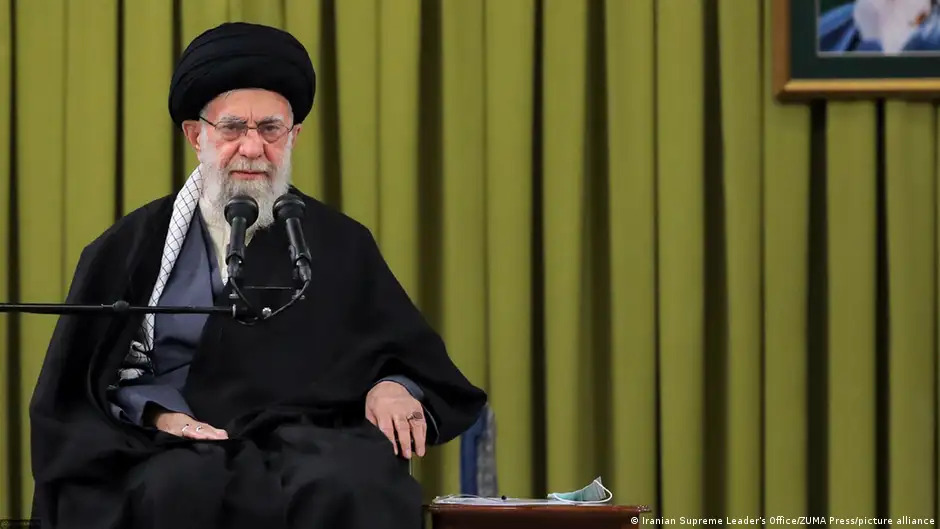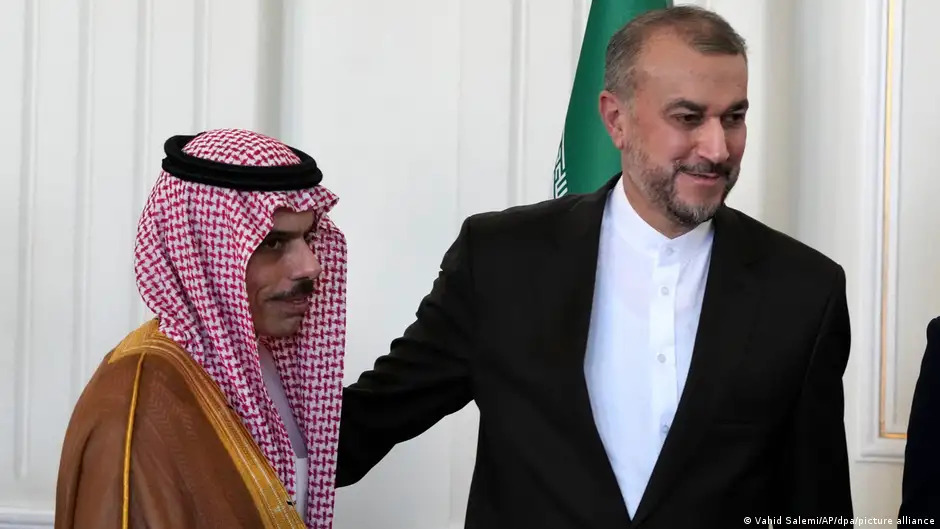The Islamic Republic's dilemma

The March 2023 agreement between Iran and Saudi Arabia, brokered by China, is generally regarded as a testament to shifting regional and global dynamics, and a major step towards putting an end to regional instability. It also demonstrated Beijing's rising international clout.
For its part, the Islamic Republic took advantage of this opportunity to deflect the international community's attention away from the suppression of the Iranian revolutionary uprising, which began in mid-September 2022 and the resulting threat of rising international isolation. Tehran was moved to agree finally to detente with Saudi Arabia.
The Iranian authorities also sought to embrace the deal as proof of the decline in U.S. power in the Middle East and the definitive advent of a post-American world order. One aspect much neglected in the debate is that this agreement created a key dilemma in the Islamic Republic's foreign policy, an unstable equilibrium between its two primary grand strategies: the regional "Axis of Resistance" and its global "Look East" policies.
Joint Trilateral Statement by the Kingdom of #Saudi Arabia, the Islamic Republic of #Iran, and the People’s Republic of #China. pic.twitter.com/MyMkcGK2s0
— Foreign Ministry (@KSAmofaEN) March 10, 2023
Both the Raisi administration and state-owned media close to Supreme Leader Ali Khamenei have expressed support for the normalisation of ties with Saudi Arabia. Meanwhile, the primary message of Tehran's propaganda is to portray the agreement as a blow to the Islamic Republic's opponents, be that Israel or the United States.
Iranian dailies have pushed the narrative that a normalisation of ties with Riyadh would bring about "a new order in West Asia" and "a new era in regional developments". General Yahya Rahim-Safavi, former commander of the Islamic Revolutionary Guard Corps (IRGC) and advisor to Khamenei, described the agreement as "a political earthquake that signals the end of American hegemony in the region", saying that Tehran's "look to the neighbours and the East will increase Iran's geopolitical weight".
The curious silence of major Iranian decision-makers
Neither of the major decision-makers in Iran – Supreme Leader Ali Khamenei himself nor the IRGC – seem, however, to have attached any special importance to the agreement, let alone hailing it as a historic turning point as many outside observers did. It was late May, when the new Sultan of Oman hailed the Iranian-Saudi deal during a visit to Tehran, before Khamenei finally broke his silence, crediting the agreement to the Ebrahim Raisi administration's "good policy of expanding ties with neighbours and regional countries".
Such a general comment that merely echoes the administration's stated objectives can be read as downplaying, if not degrading, the significance of the event. Indeed, some ten days after the deal with Riyadh was announced, Khamenei sought in his Iranian New Year address to emphasise his country's determination to support the "axis of resistance", which has been a major bone of contention between Tehran and Riyadh over the last twenty years.
The Islamic Republic's identity and survival are interwoven with the Tehran-led "axis", making it unlikely the Iranian leadership will sacrifice its regional influence for the sake of normalising ties with Riyadh. A year earlier, in March 2022, Khamenei had stressed that Iran’s presence in the Middle East "is our strategic depth; this itself is a means of strengthening the nezam [i.e. the system of the Islamic Republic], it is a means of the power of the nezam. How can we lose this, when we can and should have something like it?"
Furthermore, while the IRGC has frequently threatened Saudi Arabia in recent years, its silence over the agreement has apparently raised concerns in Riyadh about Iran's actual commitment to the deal.

The current nuclear impasse could also end up escalating. In such a scenario, according to a major architect of Iran's nuclear escalation policy in an April interview with Der Spiegel, a war would not be limited to the U.S. and Iran, but would also engulf many regional states – in other words, potentially Saudi Arabia.
Such a regional conflagration would result from the failure to revive the Joint Comprehensive Plan of Action (JCPOA) – otherwise known as the Iran nuclear deal – and the snapback of UN sanctions triggered by the EU state signatories to the JCPOA, followed by Tehran making good on its threat to withdraw not only from the deal, but also from the NPT (Nuclear Non-Proliferation Treaty).
This scenario could then prompt U.S. and/or Israeli military action to block Tehran from acquiring the nuclear bomb, with Iran resorting to targeting the interests of those powers and their perceived partners in West Asia. In other words, the Iranian–Saudi deal would be sacrificed for an Iranian policy of threatening regional escalation.
China seeking regional stability: an uncertain gamble
The role of China has added an important layer of complexity to the situation. The Iranian regime is attempting to build a coalition with Moscow and Beijing, claiming that this triangle will shape the next world order. Tehran perceives its "Look East" policy as central, not only to unlocking the political isolation of the Islamic Republic, but also to empowering it to play a global role in future.
China has helped Iran maintain its foreign revenue through oil purchases, despite existing extra-territorial U.S. sanctions. In a further attempt to boost relations, the two countries signed a 25-year partnership accord in March 2021. It is fair to say that the Islamic Republic is increasingly looking to China both politically and economically.
For its part, China is seeking to elevate its international standing by getting involved in the Middle East. The Communist Party is increasingly investing in Saudi Arabia (thereby also helping the latter realise its Vision 2030). Peace and stability between Riyadh and Tehran is therefore paramount to Beijing.
Beijing's goal of expanding its influence and economic ties in a stabilised region could, however, collide with Tehran's support for militia groups, feeding into regional tensions. Chinese leaders will need to monitor Iran's post-Saudi deal behaviour.

The rise of an unstable equilibrium in Iran’s foreign policy
Nour News, the news agency associated with Iran's Supreme National Security Council, has stressed that the agreement with Saudis "will not change the principal strategies" of Iran. This would imply that Riyadh will have to count on China's influence in Tehran to ensure the deal's implementation on the ground.
On the one hand, if Iran expands its support for armed non-state actors in the Middle East, it risks creating tensions with China and potentially jeopardising its political and economic ties with Beijing. On the other hand, if the Islamic Republic weakens its "axis of resistance" strategy, it could lose its influence and "strategic depth" in the region, becoming more vulnerable to external pressures.
This unstable equilibrium presents a serious challenge for the Iranian leadership. Pursuing regional ambitions and the resulting leverage (to be employed against the West in particular), while expanding ties to non-Western great powers requires a delicate balancing act that could have significant implications.
In an interview published just one week after the deal, Ali Bagheri, reiterated the foreign policy of the Islamic Republic during the "transition period of the global order", emphasising two key pillars: establishing long-term agreements with countries such as China and Russia, as well as strengthening the "axis of resistance" in the Middle East.
The recent agreement with Saudi Arabia, brokered by China, poses challenges to these two pillars, highlighting the emergence of an unstable equilibrium in Iran's foreign policy. It remains to be seen whether Iranian authorities will be able to strike a balance when dealing with this grand-strategic dilemma.
Amin Naeni & Ali Fathollah-Nejad
© Global Policy Journal 2023
Amin Naeni is a Ph.D. candidate and research assistant at the Alfred Deakin Institute for Citizenship and Globalisation (ADI) at the Deakin University in Melbourne. He is also a fellow at the Center for Middle East and Global Order (CMEG).
Ali Fathollah-Nejad is founder and director of CMEG, as well as the author of, most recently, The Islamic Republic in Existential Crisis: The Need for a Paradigm Shift in the EU’s Iran Policy (Paris: European Union Institute for Security Studies, Chaillot Paper, June 2023).